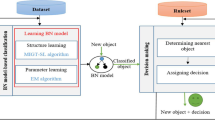Abstract
At the present time, when predicting the spread of the COVID-19 virus, the condition of patients with COVID-19 and the development of an antiviral vaccine, the method of artificial data analysis is actively used. In modern medicine, to improve the quality of medical care, increase the accuracy of diagnostics and reduce potential errors, methods based on artificial intelligence and machine learning are actively used. In this paper the reasons that affect the accuracy of the definition of coronavirus have been investigated. The set of patients is divided into five non-overlapping subsets (classes) according to the severity of the disease. To detect hidden patterns in the analysis, non-linear data transformations are used based on the calculation of the values of the class membership function for each feature, also used the formation of latent features based on generalized estimates. The values of thresholds between classes on the numerical axis are determined, both for individual features and generalized estimates of objects on the defined sets of features.
Access this chapter
Tax calculation will be finalised at checkout
Purchases are for personal use only
Similar content being viewed by others
References
Chen, N., Zhou, M., Dong, X., et al.: Epidemiological and clinical characteristics of 99 cases of 2019 novel coronavirus pneumonia in Wuhan, China: a descriptive study. Lancet 395(10223), 507–513 (2020). https://doi.org/10.1016/S0140-6736(20)30211-7
WHO Director-General’s remarks at the media briefing on 2019-nCoV on 11 February 2020 (2020). https://www.who.int/director-general/speeches/detail/who-director-general-s-remarks-at-the-media-briefing-on-2019-ncov-on-11-february-2020
Huang, C., Wang, Y., Li, X., et al.: Clinical features of patients infected with 2019 novel coronavirus in Wuhan. China. Lancet 395(10223), 497–506 (2020). https://doi.org/10.1016/S0140-6736(20)30183-5
Teich, V.D., Klajner, S., Almeida, F.A.S., et al.: Epidemiologic and clinical features of patients with COVID-19 in Brazil. Einstein (São Paulo) (2020). https://doi.org/10.31744/einstein_journal/2020AO6022
Immovilli, P., Morelli, N., Antonucci, E., et al.: COVID-19 mortality and ICU admission: the Italian experience. Crit. Care 24(1), 228 (2020). https://doi.org/10.1186/s13054-020-02957-9
Jain, V., Yuan, J.M.: Predictive symptoms and comorbidities for severe COVID-19 and intensive care unit admission: a systematic review and meta-analysis. Int. J. Public Health 65(5), 533–546 (2020). https://doi.org/10.1007/s00038-020-01390-7
Alimadadi, A.A., Aryal, S., Manandhar, I., Munroe, P.B., Joe, B., Cheng, X.: Artificial intelligence and machine learning to fight COVID-19. Physiol. Genomics 52, 200–202 (2020)
Khadjibayev, A.M., Adilova, F.T., Kasimov, K., Sharipova, V., Iskhakov, N.B.: The role of artificial intelligence in predicting Covid-19 problems: an analytical review. Bull. Emergency Med. 13(4), 75–85 (2020)
Madrakhimov, S., Rozikhodjaeva, G.A., Makharov, K.T.: Construction of fuzzy inference rules for medicine diagnostics problems. J. Phys. Conf. Ser. 2032, 012032 (2021). https://doi.org/10.1088/1742-6596/2032/1/012032
Ignatev, N.A.: Computing generalized parameters and data mining. Autom. Remote. Control. 72, 1068–1074 (2011). https://doi.org/10.1134/S0005117911050146
Ignatyev, N.A., Rakhimova, M.A.: Formation and analysis of sets of informative features of objects by pairs of classes. Artif. Intell. Decis. Making 4, 18–26 (2021). https://doi.org/10.14357/20718594210402
Ignatyev, N.: On nonlinear transformations of features based on the functions of objects belonging to classes. Pattern Recognit. Image Anal. 31, 197–204 (2021). https://doi.org/10.1134/S1054661821020085
Madrakhimov, S., Makharov, K.T., Khurramov, A.: Selection of informative features with considering data gaps. Probl. Comput. Appl. Math. 4(42), 147–157 (2022)
Broa, R., Smilde, A.K.: Principal component analysis. Anal. Methods 6, 2812–2831 (2014)
Maaten, L., Hinton, G.: Vizualizing data using t-SNE. J. Mach. Learn. Res. 9, 2579–2605 (2008)
Rocha, A., Goldenstein, S.: Multiclass from binary: expanding one-versus-all, one-versus-one and ECOC-based approaches. IEEE Trans. Neural Networks Learn. Syst. 25, 289–302 (2014). https://doi.org/10.1109/TNNLS.2013.2274735
Rakhimova, M.A.: On the quantitative estimation of the state of health by age groups, III International Book Edition of the Countries of Independent States, “The Best Young Scientist-2021”, pp. 73–77 (2021)
Ignatev, N., Lolaev, M.: Decision-making within the framework of an object’s own features space. Probl. Comput. Appl. Math. 4(13), 5–13 (2018)
Ignatyev, N., Mirzaev, A.: Selection of features into the object’s own space based on the measure of its compactness. Tomsk State Univ. J. Control Comput. Sci. 49, 55–62 (2019). https://doi.org/10.17223/19988605/49/7
Saidov, D.: Data visualization and its proof by compactness criterion of objects of classes. Int. J. Intell. Syst. Appl. (IJISA) 9, 51–58 (2017). https://doi.org/10.5815/ijisa.2017.08.06
Kim, K., et al.: Clinical features of COVID-19 in Uzbekistan. J. Korean Med. Sci. 35(45), e404 (2020). https://doi.org/10.3346/jkms.2020.35.e404
Interim guidelines for the management of patients infected with COVID-19, 6th edn. The Ministry of Health of the Republic of Uzbekistan (2020)
Responding to the COVID-19 pandemic: WHO’s action in countries, territories and areas, 2020. World Health Organization (2021)
Harris, C.R., Millman, K.J., et al.: Array programming with NumPy. Nature 585(7825), 357–362 (2020). https://doi.org/10.1038/s41586-020-2649-2
Pedregosa, F., Varoquaux, G., et al.: Scikit-learn: machine learning in Python. J. Mach. Learn. Res. 12, 2825–2830 (2011)
Author information
Authors and Affiliations
Corresponding author
Editor information
Editors and Affiliations
Rights and permissions
Copyright information
© 2024 The Author(s), under exclusive license to Springer Nature Switzerland AG
About this paper
Cite this paper
Rakhimov, B., Akrom, A., Mekhrbonu, R., Kodirbek, M. (2024). Search for Hidden Patterns in the Study of Coronavirus Patients Using Data Mining Methods. In: Aliev, R.A., et al. 12th World Conference “Intelligent System for Industrial Automation” (WCIS-2022). WCIS 2022. Lecture Notes in Networks and Systems, vol 718. Springer, Cham. https://doi.org/10.1007/978-3-031-51521-7_41
Download citation
DOI: https://doi.org/10.1007/978-3-031-51521-7_41
Published:
Publisher Name: Springer, Cham
Print ISBN: 978-3-031-51520-0
Online ISBN: 978-3-031-51521-7
eBook Packages: Intelligent Technologies and RoboticsIntelligent Technologies and Robotics (R0)




